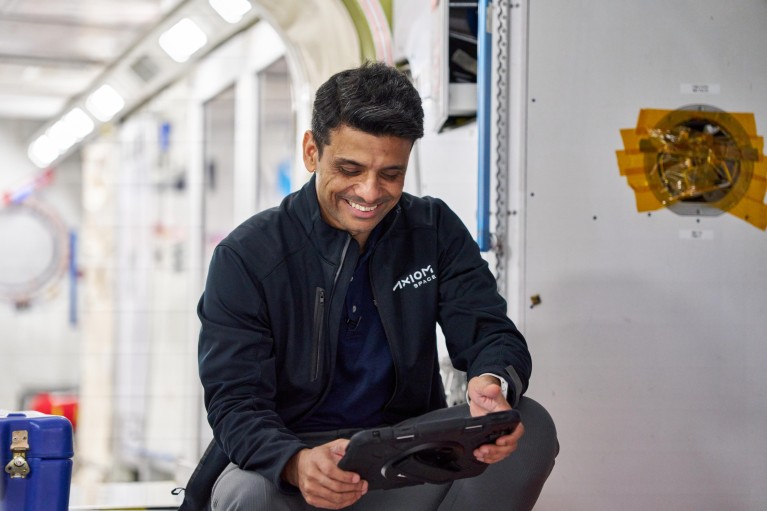
Shubhanshu Shukla interacts with a tablet in a mockup of theInternational Space Station. Credit: Axiom Space
Q. What are the primary goals of the Axiom Mission 4, and what experiments will you be conducting aboard the International Space Station (ISS)?
A. The Ax-4 mission highlights the power of international collaboration and microgravity research — and it demonstrates how commercial spaceflight can support meaningful science. For India, I’ll be conducting experiments onboard the ISS to support human spaceflight, engage in educational outreach with students, academia, and the space industry and support commercial initiatives in the space sector.
One of the key experiments involves cyanobacteria — organisms that generate oxygen and could one day support long-duration missions. We want to understand how they behave and grow in microgravity. Another experiment focuses on cognitive workload: how astronauts process visual information on screens in space. It’s about improving human-computer interaction in spacecraft environments — something especially important for India as we develop our own crewed vehicles and stations.
Another experiment I will be performing will help understand the effects of microgravity on astronaut’s cognitive load while interacting with displays — this could help us better design interfaces for our capsule and space station.
My MTech research at IISc prepared me well. I worked with biological samples, which taught me how to handle sensitive materials with precision. The hands-on experience with advanced lab tools and scientific protocols will help me navigate the unique challenges of space-based experiments.
Microgravity adds complexity, but the principles are the same.
Q. How are you preparing to conduct experiments in microgravity, and what challenges do you anticipate?
A. Training happens at NASA, Axiom Space, and international agencies like ESA and JAXA — each has hardware aboard the ISS. We simulate the procedures repeatedly, learning to adapt to microgravity conditions where every motion counts. You must think through simple tasks like transferring a fluid sample or reading a display differently. There’s no room for error — equipment floats, bubbles behave oddly, and even your own body orientation can disorient you.
I’m anticipating challenges in fine motor control and timing — things that come naturally on Earth need retraining in orbit. But that’s part of the thrill: using science to figure out new ways to do old things and hopefully discovering something we can apply back on Earth.
Q. What specific duties will you have as the Ax-4 pilot during launch, docking, and re-entry?
A. As the pilot, I’ll be monitoring Dragon’s systems during all critical phases — launch, docking with the ISS, and re-entry. During launch, I track system health, coordinate with mission control, and stay ready to troubleshoot anomalies. For docking, I oversee the approach, ensure correct alignment with the ISS docking port, and maintain constant communication with both the station crew and ground mission controllers. If anything goes wrong, I coordinate with Commander Peggy Whitson to take action.
Re-entry is equally demanding. I’ll be monitoring our descent trajectory and key safety parameters — including parachute deployment and vehicle altitude — and I’m trained to intervene manually if necessary. Every second counts in those moments.
Q. What was your astronaut selection process like, and how did you transition from Gaganyaan to the Ax-4 mission?
A. I was selected in 2020 as one of four astronauts for India’s Gaganyaan mission. The selection process was rigorous — it tested our technical skills, physical fitness, and psychological resilience. That same foundation carried over to Ax-4. Though the missions differ, the core competencies required are similar.
Ax-4 builds on our Gaganyaan training. In both, you're expected to understand spacecraft systems deeply, operate in high-pressure environments, and function as part of an international team. The Ax-4 training is more modular — we’ve trained at NASA, Axiom, ESA, and JAXA — and it includes focused segments on Dragon systems, the ISS environment, and scientific procedures.
Q. What excites you most about working in space? How do you prepare for the psychological and physical challenges?
A. Microgravity itself — floating freely, maneuvering in three dimensions — is what I’m most looking forward to. It’s going to be surreal. But beyond the novelty, the ability to do science in that environment is what really motivates me. Microgravity lets us study biological and material processes in new ways.
To prepare physically, we follow a strict regime: resistance training, cardio, and flexibility routines to counteract the effects of microgravity. Psychologically, we’re trained to handle confinement, isolation, and long-duration focus. Crew cohesion is vital. We’ve developed strong bonds during training, and that will be essential onboard.
A memorable moment was during underwater escape training — simulating a helicopter crash and sinking scenario. It was disorienting, but our teamwork shone through. That experience reinforced the trust and support we have for each other — something that’ll be just as important 400 km above Earth.
Q. What inspired you to join the Indian Air Force, and how did that lead to becoming an astronaut?
A. It started with an air show I saw in sixth grade — a fighter jet flew in low from behind, completely surprising the crowd. That moment stuck with me. When the opportunity arose, I joined the Indian Air Force in 2006 and never looked back. I’ve logged over 2,000 flight hours on aircraft like the Su-30 MKI and MiG-21, and I became a Fighter Combat Leader in 2014 and a Test Pilot in 2018.
When the Prime Minister announced India’s first human spaceflight mission on Independence Day in 2018, I knew I wanted to be part of it. The astronaut selection began in 2019 — a six-month process — and I was one of four chosen. We went to Russia’s Yuri Gagarin Cosmonaut Training Center for basic cosmonaut training. That gave us a solid technical and psychological foundation, and it’s been a stepping stone to missions like Ax-4.
